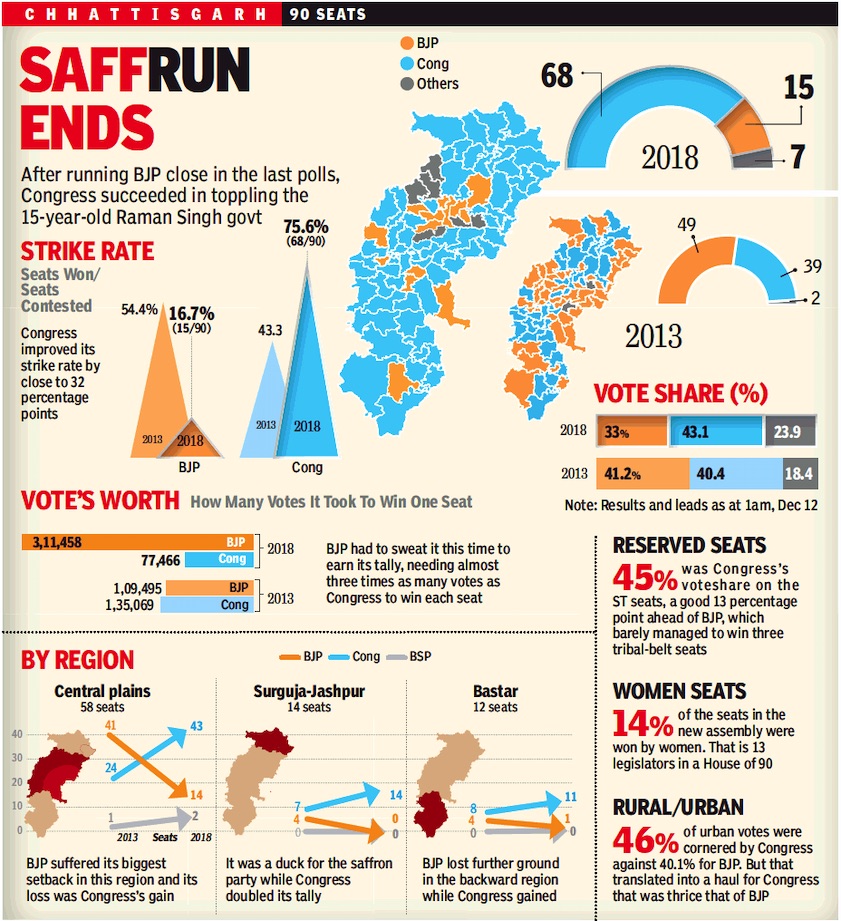Chhattisgarh: Assembly elections
This is a collection of articles archived for the excellence of their content. |
Contents |
2018
The results

Comparisons with the 2013 assembly elections
From: December 12, 1018: The Times of India
See graphic:
The results of the Chhattisgarh assembly elections, 2018
Comparisons with the 2013 assembly elections
BJP lost wherever more women voted
Women voters in Chhattisgarh seem to have drifted away from BJP. None of the ruling party candidates could win from 23 constituencies where turnout of female voters was higher than males.
Congress won by impressive margins in 20 out of these 23 seats, while the remaining three seats went to candidates of the Janata Congress Chhattisgarh-BSP alliance. It is believed that Congress won maximum number of seats in these constituencies because it had promised a ban on liquor in its election manifesto.
The highest turnout of female voters was reported from Kharsia constituency where former IAS officer OP Choudhary contested his maiden polls on BJP’s ticket. Choudhary lost to the sitting Congress legislator Umesh Patel by a margin of 16,967 votes in the constituency which saw around 86.88% turnout among women voters.
Dharamjaigarh (ST) constituency — with the second highest turnout of women voters at 85.91% — also saw Congress retaining the seat. MLA Laljeet Singh Rathia defeated his BJP rival Leenav Birju Rathia by an impressive margin of 40,335 votes.
Similarly, Congress retained eight more assembly seats, including Ramanujganj (ST), Korba, Raipur City Gramin, Sanjari Balod, Dondi Lohara (ST), Gunderdehi, Dongargaon and Khujji where women voters outnumbered men. The party also wrested Lailunga (ST), which saw the fourth highest turnout of women at 84.77%, from BJP with the victory of Chakradhar Singh Sidar.
Why the Congress won
Joseph John & Rashmi Drolia, Not Raman, It’s The Rahul Effect, December 12, 2018: The Times of India

From: Joseph John & Rashmi Drolia, Not Raman, It’s The Rahul Effect, December 12, 2018: The Times of India
Promises of farm loan waiver, MSP hike work
A Congress cyclone swept Chhattisgarh, with trends showing the party heading for a massive victory after being in the wilderness for 15 long years. It looks set for a threefourths majority, giving the once mighty BJP its worst drubbing ever.
At 11pm, Congress was en route to winning 68 seats, more than the number BJP chief Amit Shah had predicted for the BJP in the state (65).
BJP was reduced to a humiliating 16 seats, its hope that the Ajit Jogi-led alliance of Janta Congress Chhattisgarh, BSP and CPI would lead to a division of opposition votes dashed. Even outgoing chief minister Raman Singh had to fight tooth and nail against Congress’ Karuna Shukla, and at 9.30pm it looked like his victory margin — if he wins — would drop by half.
Accepting defeat, Singh said, “I am thankful that people elected us for 15 years, and made me the chief minister. BJP fought the election under my leadership and I take moral responsibility for the defeat.”
Congress national general secretary P L Punia, who worked tirelessly with PCC chief Bhupesh Baghel to revive the party, called it a “historic win”. “It has reaffirmed the faith that money, liquor and other allurements cannot overcome people’s will. People have chosen Congress and today’s victory sends out a message that democracy wins in this country,” he said.
Voters cutting across regions dominated by tribals, Scheduled Castes and farmers swung overwhelmingly towards Congress. The ruling party was routed even in state capital Raipur, considered a BJP stronghold, with only senior minister Brijmohan Agrawal leading by15,000 votes.
The Maoist-affected tribal Bastar region in the south, and tribal areas in the north, not only stood with Congress, as in the past, but also swept away sitting BJP legislators.
Farmer-dominated constituencies overwhelmingly favoured Congress, attracted by AICC chief Rahul Gandhi’s promise of a farm loan waiver within 10 days, cutting power bills by half and hiking the paddy MSP to Rs 2,500. In contrast to Congress’ specific promises, BJP’s manifesto was vague about its plans for farmers.
In the rural belt of the central plains, a major paddy area, Congress was leading in 37 constituencies, the Janata Congress-BSP alliance in seven and BJP in 13. “Undoubtedly Congress’s manifesto attracted farmers but as the MSP is decided by the Centre and is Rs 1,750 for this year, we want to know whether Congress will pay Rs 2,500 in the on-going paddy procurement. If the promise is not fulfilled, it can definitely boomerang on the party,” said BJP spokesperson Gauri Shankar Shrivas.
A majority of senior ministers lost the elections as BJP crumbled under anti-incumbency against its 15-year rule. The trend was clear from very early in the day, with even the postal ballots going against the BJP.